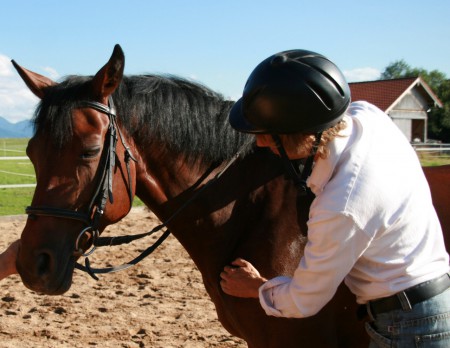Feldenkrais for Riding
„The time spended with introspection whilst taking action – and every action is movement – is insignificant, measured against the availability and agility of skill which therefore develops.“ Moshe FeldenkraisThe Feldenkrais methods helps in a pleasant manner to reveal one’s own sequences of movements, find different solutions for a subject and to train your perception for the movements of the horse. It helps to feel where the movements run through fluently and in which parts they are disturbed when being in the saddle. Whether be it in yours or the horse’s body. New ways of communication develop between horse and rider through aids. When perception gets fine and possibilities of problem-solving more varied, language can also get lower, thus finer and the effect greater.
This way of riding requests a different kind of alertness of the rider. An alertness of the own body, of everything you do and your feeling. The more aware of your own habits, the better you can evaluate your horse. A horse is the mirror of its rider. A more harmoniously union can be achieved through one’s own awareness and the revealing of new ways.
The Feldenkrais method shows us a more varied spectrum of possibilities, helps to find connections in the own body and creates a new room to manoeuvre with unusual movements. Performance and comfort increase for horse and rider.

Upcoming
Feldenkrais-Workshops
Die Feldenkrais Methode hilft auf angenehme Art und Weise die eigenen Bewegungsmuster zu erkennen, verschiedene Lösungen für ein Thema zu finden und die Wahrnehmung für die Bewegungen des Pferdes zu schulen. Sie hilft im Sattel zu fühlen, wo die Bewegungen fliesend durchlaufen und in welchen Bereichen sie gestört sind. Sei es im eigenen Körper oder in dem des Pferdes. Neue Bereiche der Kommunikation über die Hilfen entstehen zwischen Pferd und Reiter. Wird die Wahrnehmung feiner und die Lösungswege vielfältiger, kann auch die Sprache leiser, also feiner werden. Und die Wirkung größer.
Histories of students
Totally content
„Romeo is a big crossbred horse and obedient but much tensed up in the back. In this period we did a Feldenkrais lesson with the riders on their horses. They learned to turn their chests and hold their arms free so the use of the reins got softer. We also tried different versions of holding the reins. After the first 2 stops for the Feldenkrais exercise in standing, Romeo began already to stretch his back and it got soft. (During the “feel-lessons” between the periods of a Feldenkrais exercise everyone maintains contact on very light reins.) When the exercise with the reins came afterwards and his rider had contact to his bridle, he walks freely off the shoulder and with a stretched back. His rider is pleased: “My horse is content.” In gallop he stays relaxed and sweeping on both sides without problems.“
Centre of gravity on hind quarters
Anja rides a gaited horse. He is big and slender, therefore it is not easy for him to find his balance under his rider. He has the tendency to get fast as to adjust this. In this lessons we paid attention to the movements of the ribs and the differentiation of the pectoral girdle through Feldenkrais therapy. Her horse starts to walk rhythmically. Anja develops a feeling for putting down her pectoral girdle on her chest. We take a test. Anja bents a little bit forward, 1 – 2 cm maybe, her horse hastes away. She regains her feeling of putting down her pectoral girdle on her chest and her horse changes the balance from the front- to the hindquarters and moves with far reaching, harmonious strides in good balance in the speed that Anja desires.Motivation
In the same class the rider of a Friesian mare goes through the same process, but her dressage horse starts to move forward joyfully through the newly achieved balance instead of moving lazily and listlessly.
Forward
Willy, a crossbred horse, got in the class with the desire of his rider for him walking better forward. During the lesson she learned to take up the movements of her horse into her body, let them through her body and to extend and reduce the extension of his strides only by visualisation. Willy walked good forward.
Awareness through movement
Lessons in awareness through movement (ATM) are instructions with whom the student can experiment with and study independently. The instructions are an offer of occupying yourself with the interaction of different parts of the body and breathing, to get to know yourself, your habits and alternatives. It is interesting to find out which parts of the body are involved in which order in a movement. Is there a continuous chain of movement or does the movement skip certain parts? Familiar movements are looked closer at, unfamiliar ones are tried out. Therefore arise a greater variety of movement and flexibility.
Lesson on horseback
Lesson on the ground
Feldenkrais for horses

„An action should not simply be replaced by another, it is rather meant for changing the way it is carried out.”
Moshe Feldenkrais

